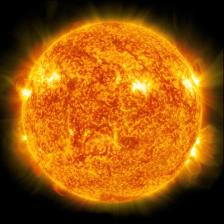What Is Angular Size?
How good are your eyes at seeing really tiny things that are really far away? How much better is the Hubble Space Telescope at doing the same thing? What do these two questions have to do with the mathematical concept of angular size? Keep on reading to find out!

How big does the Sun look to you and me from our cozy vantage point here on Earth?
Although this seems like a simple question, it’s tougher than you might think. After all, we can’t answer it using normal size units like miles or kilometers. Because I’m not asking how big it really is in real physical units. Rather, I’m asking how big it appears to be?
How can we answer that? Here’s a clue: It has something to do with an idea in math called angular size. And, as we’ll soon find out, once we understand that idea, we’ll also understand some amazing facts about human eyes and how they compare to the largest, most incredible telescopes ever built.
Sponsor: This episode is brought to you by NatureBox. Discover smarter snacking with a new NatureBox each month. Get 50% off your first box when you go to naturebox.com/qdt.
Degrees, Minutes, and Seconds
Before we start talking about the idea of angular size, how we use it to quantify how big the Sun looks, and what it tells us about human eyes and giant telescopes, we need to quickly review how we measure angles. As you probably already know, there are 360 degrees in a circle—which is why your favorite semi-circular protractor in elementary school had 180 degree marks on it.
What you may not already know is that the degree is not the smallest unit we use to measure angles. And thank goodness for that because there are many times in life (especially if you’re an astronomer) where we need to measure angles that are much smaller than 1 degree.
The degree is not the smallest unit we use to measure angles.
If we divide each degree up into 60 evenly spaced pieces, those pieces each represent an angle that is 1 arcminute across. If we further divide an arcminute up into 60 yet smaller evenly spaced pieces, those pieces each represent an angle that is 1 arcsecond across.
So we can measure angles by specifying the number of degrees, arcminutes, and arcseconds that they span. Notice that an arcsecond is an extremely tiny angle—it’s 1/3,600th of a degree. And it’s not like a degree is a very big angle to begin with!
What Is Angular Size?
Once we know how to measure an angle, we can begin talking about the angular sizes of objects. What do we mean by an object’s angular size? Well, if you draw lines from you to each side of an object in the distance, the angle between those two lines is that object’s angular size. In other words, the angular size of an object tells you how big it appears in terms of its angular extent from your vantage point.
There is a handy trick that you can use to estimate the angular size of something using nothing more than your hand. All you need to know is that if you hold your hand at arm’s length, the distance across the end of your pinky finger subtends (a fancy math word meaning “spans”) an angle of about 1 degree. How is that useful?
Apparent Size of the Sun and Moon

Now, here’s an astronomical fun fact. If you play this little game with the Moon, you’ll find that it’s angular size is almost exactly the same as the Sun’s. Of course, that’s not because the Moon is as big as the Sun. Far from it! In fact, the diameter of the Moon is about 400 times smaller than the diameter of the Sun. But the Sun happens to be about 400 times further away, which means that their angular sizes are almost identical.
Amazingly, this cosmic coincidence is what makes solar eclipses possible. If the Moon’s angular size were less than that of the Sun, total solar eclipses would be impossible (since the Moon could not cover the disk of the Sun and blot out all of its light).
Human Eyes and Space Telescopes
I mentioned earlier that 1 arcsecond is a really tiny angle, but just how small is it? Well, if you were to set a penny on its end and walk about 2.5 miles away from it, that penny would subtend an angle of about 1 arcsecond from your vantage point. Of course, there’s no way you could actually see that penny because your human eyeballs can’t resolve details smaller than a few arcminutes in size. Which means you’d have to move that penny to about 100 feet away from you before you could actually make out enough detail to realize it’s more than just a dot.
Amazingly, the Hubble Space Telescope can resolve details as small as 1/20 of an arcsecond. That means the Hubble Space Telescope would be able to see a penny from a distance of 50 miles! Which is one of the very important reasons why all of those beautiful pictures we get from it look a lot better than what you see with your unaided eye.
In the end, it’s just math.
Wrap Up

Please be sure to check out my book The Math Dude’s Quick and Dirty Guide to Algebra. And remember to become a fan of the Math Dude on Facebook where you’ll find lots of great math posted throughout the week. If you’re on Twitter, please follow me there, too.
Until next time, this is Jason Marshall with The Math Dude’s Quick and Dirty Tips to Make Math Easier. Thanks for reading, math fans!
Telescope image courtesy of Shutterstock.






